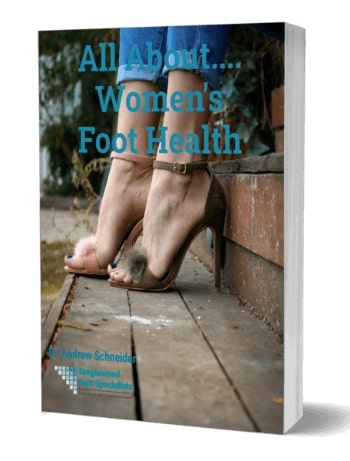Ever since Kate Middleton married Prince William and joined the British Royal family, she’s been subjected to endless amounts of scrutiny. Everything from her outfits to her hair and weight—even her maternity leave—is constantly being picked apart. And now that she's gained a new title, it's pretty clear that things will only get worse for the Princess of Wales.
Now, we're huge Kate fans, so we're going to leave her alone. At least for the most part. But we do need to take a minute and talk about her feet. Because doing so could help so many of our female patients learn a valuable lesson.
Kate Middleton has Bunions ![bunion in shoe]()
Back in 2016, Kate and Wills spent a joyous eight days in India. And while they were there, the press made a major discovery: the former Duchess of Cambridge has 'ugly' feet.
How did this fact come to light? Well, Kate respectfully removed her shoes as she entered the Ghandi museum in Delhi. And cameras were right there to catch a close-up of her unpainted toenails. Of course, she got some flak for skipping a pedicure. (Although taking a polish break is actually very healthy for your toenails.)
But the bigger issue came when we saw the state of her foot health. Because she seems to suffer from a quite serious case of hammertoes. Not to mention emerging corns and bunions.
A Hazard of the Crown?
Later, when Meghan Markle joined the family (before she promptly quit it) observers pointed out that she, too, has bunions. So, that left us wondering: are these bony bumps inevitable for royals? Well, let's unpack that question.
For working members of the royal family like Princess Kate, appearance is important. But she's a newer generation of royalty, so she's often spotted in her favorite Veja sneakers.
Still, at more formal events, Ms. Middleton’s got a propensity for wearing high heels at all times of the day. (Heck, she’s even rocked a serious wedge during a volleyball match.) As such, her duties could definitely have contributed to the classic symptoms of stiletto overuse that she exhibited in India.
Now, you should notice that we say contribute--not caused. And that's an important distinction. Because, while high heels can exacerbate bunions, hammertoes and other foot problems, they don't typically cause them. Instead, other forces are usually to blame.
What Causes Bunions?
Remember, a bunion forms on the joint beneath your big toe. It's a bony bump that develops when some force or pressue shifts over the bones of your forefoot. In turn, the top of your big toe rotates inward, making the joint at its base stick out beyond the profile of your foot.
But where does that force or pressure come from? It's true that wearing high heels or pointy-toed shoes can speed up bunion development. But they're not usually the only contributing cause.
Instead, the shape of your foot, a medical condition, or even arthritis--especially rheumatoid arthritis--may be to blame. Other forces that cause bunions to form include genetics or prior foot injuries.
Treating Bunions: Is This a Must? ![feet with bunions and calluses]()
No one wants their feet to look 'ugly.' Or be a cause for ridicule. But are there reasons other than looks to treat your bunions? The answer is: absolutely!
Small bunions don't usually cause pain or problems. But, left untreated, small bunions get bigger. And, at that point, they can cause pain and inflammation. Or make it impossible to wear closed-toe shoes without discomfort.
More importantly, it matters when you get your bunions checked by a podiatrist. If you seek early intervention, we can stop bunion development using minimally invasive treatments. Options can include padding, shoe changes and orthotics. Wait a little longer, though and your options decrease. In fact, when you come in with a big, painful bunion, there's usually only one option left. And that option is surgery.
Don't Be Kate Middleton: Treat Bunions in Houston Right Away
Now, you'd think that the Princess of Wales would have the resources and medical guidance needed to get rid of her bunions. But that doesn’t mean that we should shame the poor woman. In fact, we shouldn’t embarrass people over their foot problems or appearance. (That leads to unnecessary procedures like Cinderella surgeries.)
So, what should we do instead? Be a helpful friend and direct your bunion-afflicted pals to someone like Dr. Andrew Schneider, a podiatrist who can help. Why am I a great choice for Houston bunion care?
Here's the story. In our Houston podiatry practice, we approach women’s foot health with a non-judgment attitude. We also try to intervene in the least invasive ways possible. As a result, we can offer lifestyle solutions to avoid future problems.
At the same time, we live in the real world. So we also happily help manage pain and other symptoms once a problem like a bunion has developed. Why is that our philosophy?
We believe that your feet should feel good when you walk. And we don't think anyone should push through foot pain. But we also don’t think you should be shunned if your feet aren’t always photograph-ready. So we say give Kate Middleton a break—and a few more sneakers to work into her footwear rotation. (We also say, there are ways to fake pretty nails if you're dealing with infections or other problems. And that's why we offer Keryflex nail restoration in the office. But we digress.)
At the end of the day, you know that Kate has access to the best care to keep her feet feeling good. But that's not a right reserved for royalty. You deserve the same excellent level of care!
But how can you get foot pampering worthy of royalty if you're living stateside? As soon as your feet are in pain, take action! Contact your podiatrist in Houston, Dr. Andrew Schneider to get rid of your foot pain so you can keep wearing your favorite shoes.





















